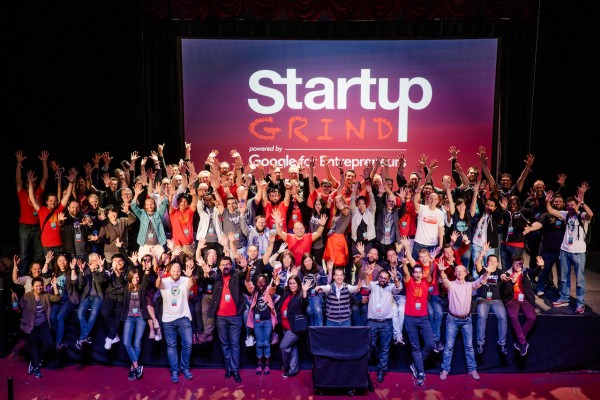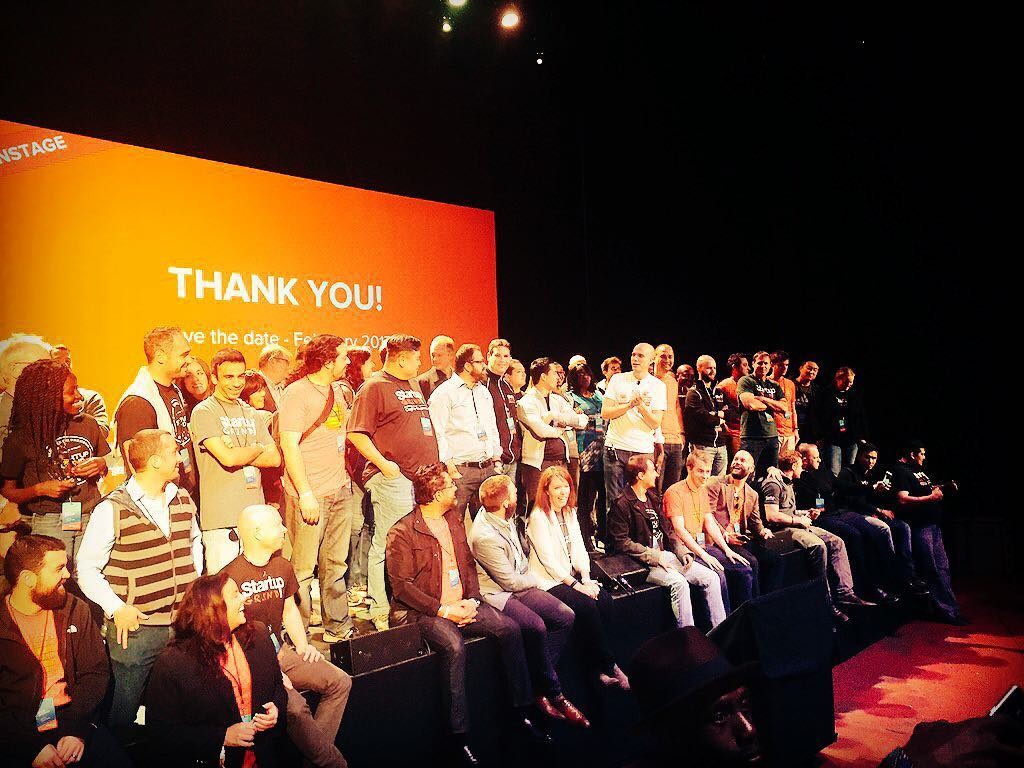
Startup Grind, a global community for entrepreneurs powered by Google Entrepreneurs, recently concluded its largest conference in the Silicon Valley. This year’s lineup was filled with Silicon Valley and USA’s largest names – Marc Andreessen (Andreessen & Horowitz), Stewart Butterfield (Slack & Flickr), Clayton Christensen (Harvard Business School), Aaron Levie (Box), Steven Chen (YouTube), Vinod Khosla (Khosla Ventures), Max Mullen (Instacart) and Rob Solomon (GoFundMe) were only some of the dozens of inspirational speakers that spoke to a sold out crowd of over 3000 entrepreneurs, students and executives. We’ve combined some brilliant learnings from select talks for our community to take note of.
Aaron Levie: Building for Enterprise
The young founder of Box was sarcastically thanked by Fortune’s Michal Lev Ram (host of his fireside chat) for walking ‘an entire block’ to the Fox Theatre from Box to make it for the talk. Aaron talked about his passion to ‘bring sexy back to enterprise,’ something that he has pursued relentlessly since 2011. He believed that when he first attacked this notion, enterprise software, crucial as ever, was becoming boring – ‘the biggest thing you’d hear was that Oracle would buy another company and integrate it in their system’ – Aaron believed it was necessary to change consumer points, make IT more attractive and let users solve their problems themselves in an attempt to increase participation in the industry.
It was ‘sort of the renaissance of the future of enterprise IT’ – consumer centric companies used to dominate enterprise in the traditional software enterprise world, which led to enterprise reaching a point where the ‘entire system was broken and too complex.’ Aaron’s desire to disrupt this distribution system, and challenge the traditional 36-month implementation system that made a solution useless by the time it was implemented drove his desire.
The talk also addressed the regulated industry issue, but Aaron’s approach and vision when questioned was very different – he envisioned a day ‘when the tech industry itself will be pointless’ and everything will be so centered around tech that the need to create solutions would not have to exist. ‘Laws and regulations will always be in conflict with what can be possible in the digital world’ but the fact that debate currently exists, between the likes of Uber and regulators is something Aaron found as an encouraging sign.

Clayton Christensen: The Capitalist Dilemma
Undoubtedly one of the most underrated speakers and celebrities of the conference, Clay’s ideologies and his research on the nature of innovation and the capitalist economy caught everyone’s eye. Clayton was labeled the world’s most innovative business management thinker in 2011 and 2013. His insight on innovation was transforming. ‘As companies tend to innovate faster than their customers’ needs evolve, most organizations eventually end up producing products or services that are actually too sophisticated, too expensive, and too complicated for many customers in their market.’ By pursuing such ‘sustainable innovations,’ companies expose themselves to ‘disruptive innovations’ which allows customers at the bottom of a market to access something which was initially meant for consumers with either a high amount of skill or money. ‘Because these lower tiers of the market offer lower gross margins, they are unattractive to other firms moving upward in the market, creating space at the bottom of the market for new disruptive competitors to emerge.’ The result of both disruptive and sustainable innovations is a third form, ‘efficiency innovation,’ which by its nature tends to eliminate jobs from an economy, at the expense of increasing cash flow.
Traditionally, disruptive innovations lead to sustainable innovations, which lead to efficient innovations, and efficient innovations fuel disruptive innovations. This cycle is crucial to job creation in an economy. But where the problem exists, is that the link from efficient to disruptive innovations has slowly been eroded by ‘doctrines in finance’ where the need to create better ratios and numbers has cut a crucial link in the economy. Success being measured by IRR, RoA, ROCE and other ratios has left the American economy with a problem. This being said by one of the most respected business professors at Harvard, the crowd stood stunned.
Clayton Christensen & Marc Andreessen: Silicon Valley and the State of Disruption
A number of questions on innovation and disruption were raised by host Derek Andersen during the talk. Watching a business professor with interesting theories in conversation with the walking ‘stamp of approval’ of the Silicon Valley and one of its best known VCs was enlightening for the audience.
Marc described the importance of knowing the algebra of business in the Silicon Valley, one that’s responsible for disruption: if big companies are not well run, their laziness, lack of information and redundancy allows startups the perfect window to pick on them. Well run companies need to be focused on margins, customers and needs – their lack of competence can open a gap for startups to exploit, easily.
An interesting discussion also involved Clay arguing with Marc on the nature of abundance of capital in the Silicon Valley. As Clay put it, too much money exists in venture capital – in a time when people can afford to ‘waste capital’ to seek disruption, innovation can slow down and inefficiency can take over. Marc on the other hand, though acknowledging the lack of the likes of new Facebooks, believed that not as much money was in venture capital as deserved to be. He argued that $6tn worth of bonds in the US actually have a negative yield – the critical issue to him was not the possibility of a tech bubble, but the concern of money being used in ridiculously poor alternatives. ‘If you look at that, $50bn a year going in startups is nothing – $1tn is currently being returned in stocks as dividends. Where is that other $950bn going, and why isn’t it being put in startups?’
Both intellectuals were also asked to comment on the possible lack of innovation at Apple – Clay believed research was not being addressed properly. ‘Steve Jobs did his research in front of a mirror,’ he remarked, as he talked about worries that cadence, modularity and a lack of self-reflection are beginning to characterize Apple. Marc on the other hand, lightened tensions by commenting on the increased standards of quality in the valley: ‘It’s a sign that we’re doing good, when to a company with $3bn in revenue and 300m users, we say ‘you suck!’’ They both agreed that it was good for the business environment that disrupted companies are also being disrupted and not allowed to settle, something that they believed pushes the need for the perfect products and solutions.
In terms of advice, Marc and Clay were clear: CEOs need to possess the ability to ‘wrap their head around a problem’ and ‘have the fortitude to go create the necessary change.’ Such a mentality, is crucial to the success of startups. Such qualities are in their opinion what make the Silicon Valley increasingly fail-proof, rigorous & sharp, and force founders to always be on their feet.
Sukhinder Singh Cassidy: From Founder to CEO – How to Scale Yourself and Your Team
One of the most dynamic women leading the Silicon Valley, Sukhinder is the founder of Joyus.com, the world’s first web shopping entertainment network, and also the founder of theBoardlist, a curated marketplace designed to help discover exceptional women leaders for private company boards, especially in the tech industry. Her talk focused on the importance of finding balance between being entrepreneurial and executive, and visionary and detail-oriented as the leader of a team. Her talk had seven lessons for entrepreneurs:
- Find Trademark Strengths, in both you and your team, and milk those strengths for the maximum possible benefits.
- Always Recruit, for both jobs that are open, and not available. She believed CEOs need to possess the ability to recruit the right talent at the right time, and that more than half the time a CEO dedicates to his business should be in strengthening their team with better enforcements, not maintaining it for what it is instead.
- You Manage Me, I Shouldn’t Have to Manage You: Sukhinder raised an important philosophy – you can’t actively manage everyone – instead, workers should have ideas and solutions in their pockets in a way where THEY can manage their seniors – ‘if you walk into a room without a vision, you’ll be filled with other people’s visions,’ Sukhinder remarked.
- Balance Heads Up vs. Heads Down: It’s important to know when to have to put your head down and work, or pause, hire, find investors, and fix problems.
- Deal with the Energy Drainers and Hire Energy Gainers: managing at the micro-level is a massive drain for CEOs, the opportunity cost of which involves strategizing and expanding a growing business. At the same time, it’s important to identify the work that motivates you, while sidelining managing at the micro level and other tasks that drain energy.
- Find your Priest and Claim your Religion: This cannot be your girlfriend, your investor or someone at work. It’s crucial to know what you are, admit your mistakes, and vent to a mentor who can guide you to work for solutions.
- Drafting is Key: The biggest job is to create a team that wins. Your team must always be ahead of its competition. This is crucial in helping you manage both your products and your energy later on in your Startup life.
